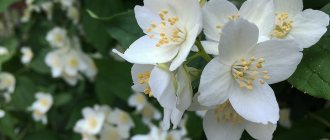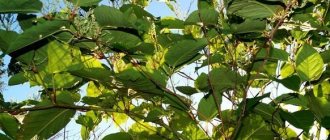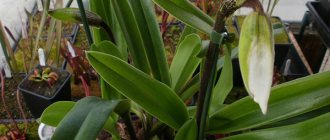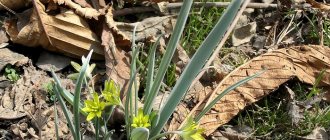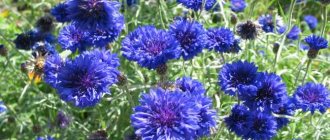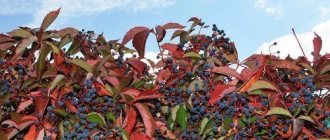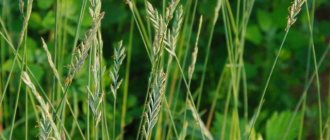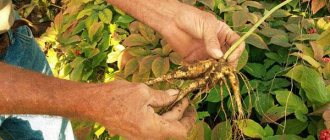Fruits and berries » Grapes
0
899
Article rating
Kira Stoletova
Vinegrass is an ornamental plant that resembles ivy in appearance but produces fruit similar to grapes. This is a vine-type crop that climbs walls and can create a hedge. There is aconite-leaved vineyard, short-peduncle vineyard and Ussuri vineyard.
Vineyard aconitifolia
Description of the plant and species
The genus Vineyard, or Ampelopsis, includes 24 species of plants that vaguely resemble grapes. These are deciduous vines up to 3 meters long or low shrubs with deeply cut leaf blades. Young leaves are light green and develop reddish and purple markings as they age. Large serrated edges give the foliage the effect of a lace-trimmed patchwork quilt.
Ampelopsis easily climbs onto a support with the help of curling antennae. Externally, the plant resembles a girl's grape, but differs from it in the absence of suckers on the antennae. In addition, the vineyard is more compact and can be successfully grown even in small spaces as a houseplant with excellent decorative properties.
Externally, the plant resembles a girl's grape
The plant blooms inconspicuously, with small faded “stars” collected in loose shields. Its inedible berries ripen unevenly, so on one ampelopsis vine you can simultaneously find green, blue, lilac and even orange fruits. Because of their pronounced shine, ampelopsis is popularly called “porcelain berries.”
Popular types
Aconitofolia is a vine that grows up to 3 meters in height.
The leaves are green on long petioles. The berries are initially yellow-orange and turn blue when ripe. The variety is winter-hardy. Its homeland is northern China. Heart-shaped - the leaves of this species are not similar to the previous ones. They are heart-shaped, hence the name. The liana is powerful. The berries are greenish-blue.
Short-peduncle - a vine with dark green glossy leaves, growing in height up to 6-7 meters. Especially elegant variety "Elegance". It has green leaves with pink, creamy white strokes. And the berries are first green, then purple, and when fully ripe they look like scatterings of turquoise. Homeland - Primorsky Territory, China.
Variegated - the leaves of this species are also green and have different shapes, hence the name. It can grow up to 9 meters in height. The berries are light blue. Homeland - Korea, South Sakhalin, Kuril Islands.
Japanese is a small liana, it can even be classified as a ground cover (read about the ground cover ayuga in the article at the link), it has glossy beautiful leaves. When ripe, the berries are blue and lilac with a black dot. Homeland is Japan, China, Korea.
In my garden there is a short-peduncle variety called "Elegance". It is less frost-resistant than all the previous ones.
For successful wintering, a secure shelter or growing in a container with wintering indoors is recommended.
Can also be grown as a houseplant. In room conditions, this is a fairly docile vine that does not require much attention.
Moderate watering, sufficient lighting and wintering in a cool room are all the requirements for successful cultivation. My plant lives in the garden and has been wintering for 5 years, almost without shelter. Only the fallen leaves of the peach tree provide some protection.
At first I didn’t know that ampelopsis was not very winter-hardy, because it was given to me as a small cutting without any characteristics or name. Later, when I determined the name of the plant, I realized that there was no need for shelter. Winters normally. It grows in my garden as a ground cover plant. Of course, he would not have survived the winter on a support.
The following types of plants are most often found in indoor and garden floriculture.
- Short-peduncle or glandular vine (Ampelopsis brevipedunculata). It has a flexible stem, which allows it to be used for decorating hedges. Particularly popular is the ferruginous vineyard variety Elegance, with carved sharp lobes of leaves and an unusual range of colors, even white.
- Aconitifolia vine (Ampelopsis aconitifolia). Valued for its frost resistance, it can be successfully grown in the climatic conditions of the Moscow region in open ground.
- Heart-shaped vineyard (Ampelopsis cordata). A North American species with entire linden-like leaves.
- Japanese vineyard (Ampelopsis japonica). Compact habit with graceful, lacy, solid green foliage. It looks simpler than others, but is most suitable for landscaping apartments.
Caring for a vineyard at home
Growing a vineyard is a simple process. It will need attention, in particular, regular watering without extremes. But despite this, ampelopsis cannot be classified as a capricious crop. Active care during the growing season and more modest care in winter will allow you to decorate the interior with the luxurious leaves of this crop. This is a light-loving and cool-wintering plant that tolerates pruning well and responds gratefully to minimal care.
Lighting for ampelopsis
Ampelopsis is rightfully considered a light-loving vine. This plant loves good lighting and feels comfortable both on eastern or western windowsills, and in a bright place with dim lighting. The vineyard needs to be protected from direct sunlight only in summer, and even then it is only afraid of the midday sun. This plant responds well to fluctuations in light and does not like artificial lighting too much. Ampelopsis is able to adapt to partial shade if it is gradually accustomed to poorer lighting, but in such conditions it can partially change the color of its leaves and become somewhat elongated.
Vineyard (Ampelopsis). © Hiromi Sato
Comfortable temperature conditions
The basis for success in growing ampelopsis is mainly considered to be the provision of a cool winter. The plant should be kept cool during the resting phase after dropping its leaves. The optimal maintenance regime for the rest period is a temperature of 10 to 12 degrees. But the older ampelopsis becomes, the better it adapts to warmer wintering. With careful care and increased lighting in winter, it can overwinter in temperatures of about 18 degrees Celsius, recover well and delight with equally beautiful greenery. The minimum permissible values are about 5 degrees Celsius.
The rest of the year, the vineyard feels great in the usual “room” temperature range and develops well even in the heat. True, if the air temperature exceeds 25 degrees, ampelopsis’s need for fresh air and spraying increases.
In the summer, the vineyard can not only be taken out into the fresh air, placed on balconies and terraces and even in the garden, but also planted in open ground and dug into the soil. The vineyard loves frequent ventilation, grows well in rooms with open windows and doors, and is absolutely not afraid of drafts.
Watering and air humidity
During the active development stage, ampelopsis needs fairly active watering. This plant does not tolerate drought or waterlogging, and it is necessary to provide it with as stable an environment as possible. Even a short period of drought can cause a vineyard to drop all its leaves. In spring and summer, from March to November, ampelopsis is watered actively, often and abundantly, immediately after the top centimeter of the substrate in the pots has dried (but making sure that the humidity is not excessive). During winter everything depends on the temperatures.
During cool wintering, it is kept in almost semi-dry conditions, providing light, infrequent watering that maintains only minimal soil moisture. During warm wintering, humidity is reduced by half compared to summer. The transition to the active development phase, the appearance of the first signs of growth, serves as a signal that watering should be made more abundant. It is not necessary to stretch out the transition from scanty winter to abundant summer watering. The optimal frequency of procedures for a vineyard is about 1 time every 2 days in summer and 1 time every 10 days in winter. Ampelopsis always prefers less frequent but abundant watering.
There is no need to increase the air humidity in the room for ampelopsis. The exception is during periods when the plant is exposed to air temperatures above optimal ranges. In hot weather, ampelopsis must be sprayed at least 2-3 times a week to compensate for hotter conditions. And in the summer, spraying can be done even daily. Hot air from heating systems is compensated in the same way.
Short-peduncle vineyard (Ampelopsis brevipedunculata). © Caitlin W.
Feeding for ampelopsis
An actively growing vine needs fairly frequent feeding, which is best applied once every 2-3 weeks. Any universal fertilizer for indoor plants or special mixtures of fertilizers for ornamental foliage plants are suitable for the vineyard, thanks to which the variegated leaf pattern becomes more vibrant. Feeding for this plant is applied from April to October.
Ampelopsis pruning
Ampelopsis is not afraid of any formation and tolerates pruning very well. Moreover, it is the key to longevity and the formation of a denser and more lush bush. The stronger the pruning, the better the shoots branch and the thicker this vine grows. Thanks to formative pruning, the size of the plant can be controlled down to the most compact potted forms.
Ampelopsis must be tied to supports and guided: due to the lack of suction cups on its antennae, it cannot climb up on its own. It grows well on figured bases, and on ladders, and on trellises, and in ampels or cascades.
In order for the plant to maintain its variegated color, it is better to regularly remove shoots with green leaves. If you leave them on the plant, the number of simple branches will constantly increase.
Transplantation, containers and substrate
The substrate for vineyards is selected very carefully. This crop prefers nutritious, clayey soil structure with an alkaline reaction. For ampelopsis, a soil mixture consisting of humus soil, sand and double shares of turf and leaf soil is suitable.
When choosing containers for growing vineyards, you should take into account that they are most comfortable in containers whose height exceeds their diameter. It has a powerful, fairly deep root system that does not develop well in wide pots.
The optimal frequency of transplants is annually for young and once every 3 years for powerful ampelopsis. Vineyards are replanted as soon as the first signs of growth appear in early spring. In this case, it is advisable for the plant to undergo classical replanting rather than transshipment. A medium drainage is placed at the bottom.
Short-peduncle vineyard (Ampelopsis brevipedunculata). © Ryan Somma
Distribution and habitats
Ampelopsis grows wild in Central and East Asia. The center of species diversity for this genus is China. In different regions of the country there are both numerous Japanese vineyards and aconite-leaved vineyard, listed in the Red Book. The plants were introduced to North America, where they are widely used as a landscape design element in the central and eastern states.
The liana prefers slightly mountainous terrain, covered with temperate and subtropical forests, where it finds a sufficient amount of moisture, light shading and support for its weak shoots.
The vineyard prefers slightly mountainous terrain
Chemical composition and application
Ampelopsis is not included in the State Pharmacopoeia of the Russian Federation, but some of its species are studied by pharmacists in order to expand the list of medicinal plants. Found in its roots:
- various polysaccharides
- flavonoid kaempferitrin;
- minerals: potassium, iron, phosphorus, magnesium.
Oriental medicine uses Japanese vineyard as a medicinal plant. On its basis, preparations for external use are prepared for the treatment of burns, frostbite, ulcers, abscesses, carbuncles, syphilis and even leprosy.
Collection, preparation, storage and recipes
The medicinal raw materials of the vineyard are the roots. They are harvested outside the active growing season - in March or October. When harvested in the wild, some plants are left untouched to restore the population.
The roots are cut into pieces 5-6 cm long, laid out on a baking sheet in a thin layer and dried in dryers at a temperature not exceeding 55 degrees. Finished raw materials are stored in paper or cardboard boxes for no more than 3 years.
Before preparing the preparations, the roots are crushed with a coffee grinder in coarse grinding mode.
The most famous are 2 recipes based on the vineyard:
- Decoction. Pour two tablespoons of crushed plant roots into a glass of boiling water and simmer in a water bath for half an hour, then leave for another 2 hours. The strained and cooled decoction is taken in a third of a glass 2 times a day before meals for syphilis.
- Ointment. Five tablespoons of crushed ampelopsis roots are added to 200 g of pork fat, placed in an enamel container, brought to a boil, then cooled without ceasing to stir. Used as a rub for joint pain.
The king of noble drinks - grapes - has many relatives who are not inferior to him in decorativeness. Among them is ampelopsis - a bright, elegant vine that can decorate an apartment, office and garden plot with graceful, color-changing foliage and “porcelain” berries.
Medicinal properties and harm
The main active ingredient of the vineyard is the flavonoid kaempferitrin. The medicinal properties of the plant are associated with it:
- astringent;
- hypotensive;
- painkiller;
- hemostatic;
- anti-inflammatory.
It is considered promising to study the anticancer activity of ampelopsis and its ability to have a beneficial effect on the state of the cardiovascular system.
There are no serious contraindications for the use of the plant. Vineyard is not recommended for use by pregnant women, nursing mothers and persons with individual intolerance to ampelopsis drugs.
Cultivation and use in landscape design
In open ground, a well-lit place with light shading during the midday hours is selected for the vineyard. Pergolas, hedges, any trees and shrubs, such as Weymouth pine or cypress, are suitable for support. Ampelopsis is used to frame flower beds and flower beds; against its background, tapeworms such as tree peonies, rhododendrons and hydrangeas look great. An impressive composition on a vertical wall made of ampelopsis and clematis.
The plant is propagated by cuttings or layering. If you want to get a vine from seeds, you will have to grow seedlings. For the winter, it is advisable to remove ampelopsis from its supports and cover it with agrofibre.
The plant is propagated by cuttings or layering
Japanese vineyard is used as a potted crop. It requires large pots, abundant light and temperatures no higher than 15-16 degrees during the dormant period. The plant grows slowly for the first year or two, then very quickly, so it must be placed taking into account the length of the vines of at least 2 m.
Indoors, Japanese vineyards can be affected by diseases and pests. Plants should be systematically inspected for the appearance of aphids, whiteflies, as well as fusarium and gray rot.
Japanese vineyard
Japanese vineyard (lat. Ampelopsis japonica) is a tree-like vine; species of the genus Vineyard of the Grape family. It is found naturally in Japan, China, Korea and in the southern part of the Primorsky Territory of Russia.
Characteristics of culture
Japanese vineyard is a woody climbing or recumbent vine with rather thin and flexible shoots that cling to support with the help of a few twisting tendrils. It differs from other species in its beautiful foliage. The leaves are leathery, long, shiny, palm-shaped, consisting of three or five leaflets. The median leaves are palmately dissected or pinnately dissected, the outer ones are wedge-shaped or three-lobed. The leaves have a bluish color on the inside.
In autumn, the foliage becomes especially attractive, turning a deep red. The flowers are small, green, up to 6 mm in diameter, collected in multi-flowered inflorescences. The fruits are spherical, bluish-violet, pale, usually with black dots. The Japanese vineyard blooms in June and lasts about 40 days. The species in question is not frost-resistant; in cold winters it is affected by frost. Widely used in landscaping, mainly in the southern regions and the Far East of Russia.
Application in medicine
The roots, stems and leaves of Japanese vine are used in Chinese medicine. As you know, roots and leaves contain alkaloids and flavonoids, as well as polysaccharides, amino acids, glycosides and other substances. Decoctions of the roots are used as a diuretic, antiemetic, astringent and hypotensive agent. They are effective for diarrhea and chronic rheumatism. Various compresses are often prepared from the leaves, which relieve pain and heal burns, injuries, purulent inflammations, ulcers, abscesses and other ailments.
Growing
The Japanese vineyard does not have any special requirements for growing conditions. It is advisable to plant the crop in bright areas protected from cold winds. Soils are recommended to be loose, moist, not clogged with perennial weeds, with a neutral or slightly acidic pH. It is undesirable to plant Japanese vineyards on areas with highly acidic, heavy, clayey, saline and waterlogged soils. It is not forbidden to grow the species in question in containers; this is especially true for gardeners in central Russia. For the winter, plants along with containers are brought into cool rooms and sent back to the garden with the onset of stable warmth, while providing protection from the scorching rays of the sun.
Pests and ways to combat them
With improper care or unfavorable conditions, the Japanese vineyard is attacked by various pests, which are sometimes very difficult to get rid of. The leaf roller is considered to be one of the most dangerous pests; it can also cause harm to cultivated species and grape varieties. There are different types of leafrollers, for example, the cluster leafroller can damage the buds, flowers and berries of the vineyard.
To prevent the appearance of pests, it is necessary to carefully care for the plants, clearing the stem area of old foliage and removing old bark, because this is where leaf rollers overwinter. In case of massive damage, insectoacaricides are used, such as Zolon, Fozalon, Ekamen, Sumicidin, etc. Spraying is carried out at intervals of 10-12 days. A solution of chlorophos (at the rate of 30 g per 10 liters of water) is effective in the fight against leaf rollers. In this case, the treatment is carried out at the moment of swelling of the buds, and then after they open.
Article on the topic: Mouse peas - beneficial properties, description
Spider mites are no less dangerous for Japanese vineyards. It easily endures even harsh winters, hiding in the bark of grapes and fallen leaves. That is why, with the onset of spring, it is necessary to remove fallen leaves under the vines and treat the soil with special preparations. To combat spider mites, treatment with solutions of Fozalon or Keltan is recommended; you can also use Neoron or Nitrofen. Spraying is carried out once every two weeks, alternating drugs, because spider mites often show resistance to one or another substance.

